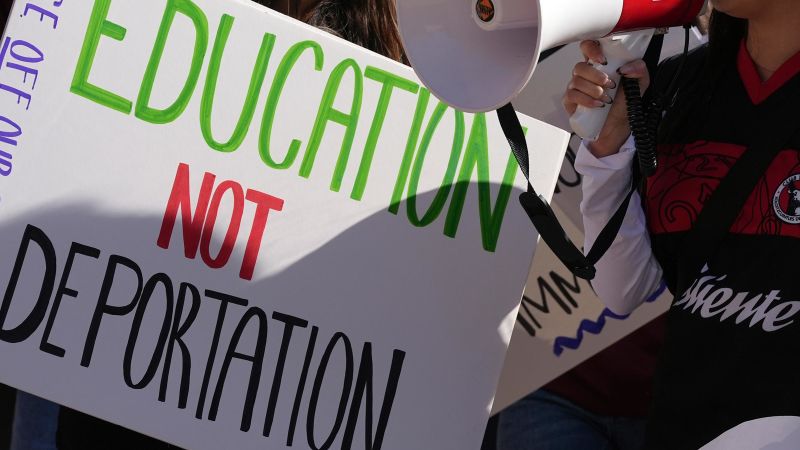In a significant and contentious legal affair, the Trump administration was compelled to divulge new details regarding its controversial operation that aimed to revoke the immigration records of a sizable number of international students. A federal judge articulated her discontent with the episode, labeling it a blatant violation of due process that left her feeling “concerned” and “troubled.” This revelation comes as a response to ongoing criticism concerning the manner in which the administration has managed the immigration statuses of thousands of international students studying in the United States.
This issue gained traction as a Department of Homeland Security (DHS) official revealed in a courtroom setting that the administration’s actions hinged upon data sourced from the National Crime Information Center, a registry that logs individuals’ interactions with law enforcement agencies. This approach proved problematic for numerous international students who had only minor legal issues, such as traffic violations or dismissed misdemeanor charges. Consequently, these students found themselves ensnared in a confusing legal limbo, which prompted at least 100 of them to initiate lawsuits in recent weeks, amplifying their grievances against the administration’s heavy-handed methods.
The courtroom testimony delivered by Andre Watson, a senior figure within the DHS’ National Security Division for Homeland Security Investigations, shed further light on the operations. Watson disclosed that a team of 10 to 20 personnel was assigned the task of sifting through names from the pool of 1.3 million international students. The method involved a cursory, centralized review that only ensured the individual in question matched the name recorded in a government educational system known as SEVIS, which tracks compliance with visa obligations. This lack of thorough individual examination raised alarms in the judiciary, prompting Judge Ana Reyes to insist on Watson’s presence to elucidate further on the matters during the proceedings.
Judge Reyes was particularly determined to comprehend the rationale behind the drastic actions taken against the students, given that previous hearings were hindered by the Justice Department’s failure to provide necessary information. As legal professionals expressed their frustrations over the administration’s refusal to transparently engage with the judicial inquiries, the then-recent announcement from the administration to retract these measures and reinstate the students’ immigration records hardly quelled the scrutiny under which they had come.
The Justice Department’s stance, contending that canceling a SEVIS record did not necessarily terminate a student’s legal status, was significantly undermined when the repercussions of these cancelations were analyzed. Schools had notified students to halt attendance and work with their on-campus jobs, which ultimately led many affected students to inadvertently lose their visa status, putting them at risk of deportation. The DHS’s own website reinforced this concern, stating that a terminated SEVIS record necessitated either immediate departure from the United States or a formal application for reinstatement.
Watson further clarified that the DHS’s operations spanned a few weeks, during which they began with an initial pool of 16,000 potential matches, eventually narrowing the list down to approximately 6,400 names. The names were forwarded to the State Department for additional review, which subsequently resulted in visa revocations for numerous students. However, the resultant termination of SEVIS records affected not just those students with canceled visas but also many who were merely flagged as matches, raising questions about the operational rationale behind such sweeping measures.
One particularly troubling case discussed involved a student named Akshar Patel, who faced record cancellations connected to a reckless driving charge that had long been dismissed. Judge Reyes articulated her incredulity over a government approach that could result in the deportation of individuals for offenses as trivial as speeding tickets, emphasizing the absurdity of penalizing someone like Patel, who was nearing graduation.
Reyes’s insistence on transparency was apparent, as she sought clarity on how the decisions were made and communicated to educational institutions. Watson’s defense fell short as he failed to identify any proactive communication efforts regarding their intentions. Additionally, the Justice Department’s attorney, Johnny Walker, acknowledged the imprecise language surrounding record terminations, admitting it was potentially misleading despite his inability to provide comprehensive details regarding the contractors involved in the operation.
Ultimately, Judge Reyes lamented the chaos and confusion created by the administration’s approach, drawing attention to the legal burdens placed on students forced to seek representation and defend their status. She regretted the situation could have been avoided had the administration taken a more deliberate approach, rather than rushing through the processes outlined. In conclusion, this unfolding saga underscores the complex interplay of immigration policy and the rights of international students amid a politically charged atmosphere, while revealing critical gaps in communication and procedural integrity within the government.



